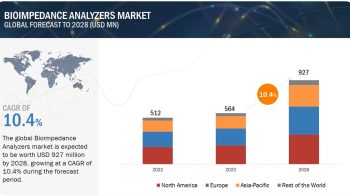The global Digital PCR Market is highly competitive. The market is estimated to grow to USD 7.6 billion by 2025 from USD 4.9 billion in 2020, at a CAGR of 9.0%. Factors such as the rising incidence of target infectious diseases and genetic disorders; technological advancements in PCR technologies; increasing investments, funds, and grants; increasing use of biomarker profiling for disease diagnostics; and successful completion of the Human Genome Project are driving the growth of this market. However, the high instrument costs—especially that of dPCR—and the technical limitations of PCR have restricted their greater use.
The global dPCR and qPCR market is highly competitive, with many large, medium-sized, and small market players. As of the financial year ended in March 2019, the global Digital PCR Market was dominated by Thermo Fisher Scientific (US), Bio-Rad Laboratories Inc. (US), and F. Hoffmann-La Roche, Ltd. (Switzerland).
Thermo Fisher Scientific held the leading position in the dPCR and qPCR market in 2019. Thermo Fisher Scientific focuses on strengthening its position in the market by adopting organic and inorganic strategies such as product launches and expansions. In line with this strategy, Thermo Fisher Scientific launched several products, including the SureTect Cronobacter Species Real-Time PCR Assay (2016), Axiom Africa Array (2017), QuantStudio 5 Real-Time PCR System (2017), and TaqMan Digital PCR Liquid Biopsy Assays (2017). To combat the COVID-19 outbreak, Thermo Fisher Scientific also developed several PCR kits and assays for diagnostics and research. It received US FDA EUA for the SARS‑CoV‑2 multiplex real-time PCR test and launched the AcroMetrix Coronavirus 2019 (COVID-19) RNA Control in 2020.
Bio-Rad Laboratories is the second-largest player in the Digital PCR Market. To further increase its share in the Digital PCR Market, the company focuses on growth strategies such as acquisitions and new product launches and approvals. During 2017–2019, Bio-Rad Laboratories witnessed a steady rise in the profit margins and annual revenue of its Life Science segment, mainly driven by the recent commercialization of its dPCR and qPCR instruments, assays, and software. The company is focused on the development and commercialization of innovative dPCR and qPCR products that are highly efficient and can be used for clinical diagnosis. In the last three years, Bio-Rad has also launched several dPCR and qPCR products to meet the growing market demand for novel clinical diagnostics. In addition to this, the acquisition of RainDance Technologies in 2017 enabled Bio-Rad to strengthen its position in the dPCR market.
Drivers: Increasing use of biomarker profiling for disease diagnostics
Biomarkers or genomic markers are characteristic molecules such as nucleic acids (including DNA and micro RNA or mRNA) that can be detected and quantified in body fluids and tissues. A biomarker can be a reliable, specific source for understanding the nature of a disease and drug response by the process of molecular profiling at the epigenetic, genetic, and protein levels. Currently, biomarker analysis is used for diagnostic testing procedures, monitoring the efficacy of treatment, and developing new drugs (especially for cancer or cardiovascular diseases). Biomarker analysis uses qPCR and dPCR technology for detecting and quantifying genetic material from the isolated sample. Over the past decade, biomarker analysis procedures have gained importance in the clinical diagnosis and prognosis of diseases, with an increasing number of public and private organizations focusing on R&D into novel techniques for monitoring disease progression and developing personalized medicines and treatment options.
Opportunities: Shift from plant-derived to genome-based drug discovery
Plant-derived drug candidates used for disease management often belong to a chemically similar class of natural products that show almost identical biological activity and often result in a similar set of therapeutic limitations (side-effects, contraindications, dose limits, and site of action). In addition, these natural products may have an unknown site of biological action that leads to unpredictable biological activity and side effects. The therapeutic limitations of plant-derived drugs can be addressed with gene-based drug candidates that have known sites of action (specific genes or proteins).
Related Links
https://www.marketsandmarkets.com/Market-Reports/digital-pcr-market-174151204.html
https://www.marketsandmarkets.com/ResearchInsight/digital-pcr-market.asp
https://www.marketsandmarkets.com/PressReleases/digital-pcr.asp
